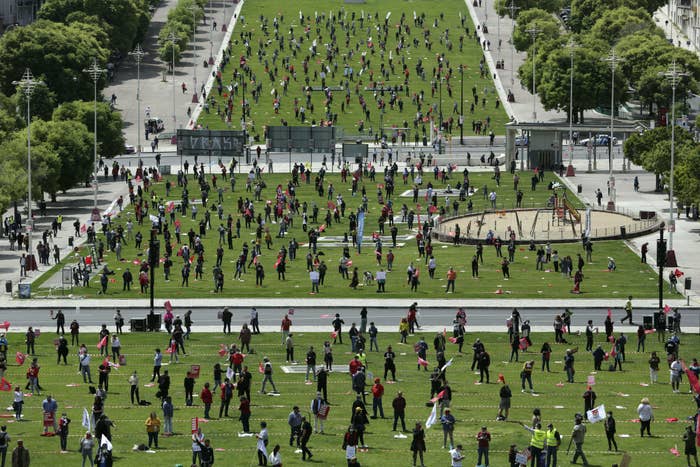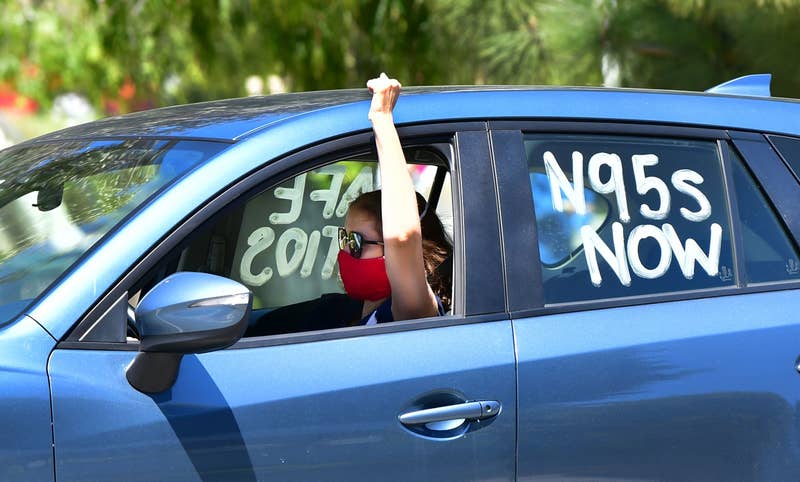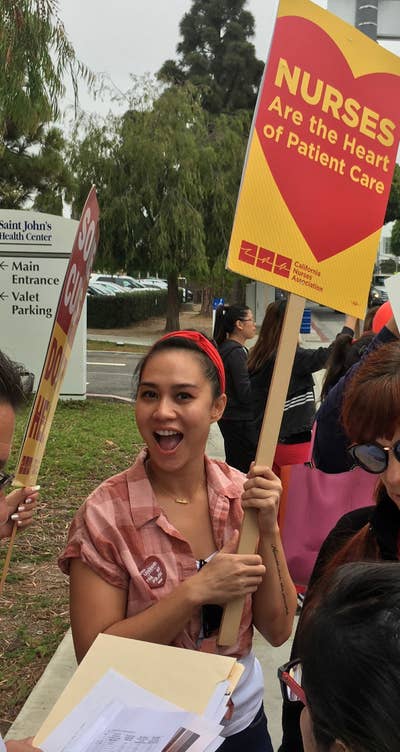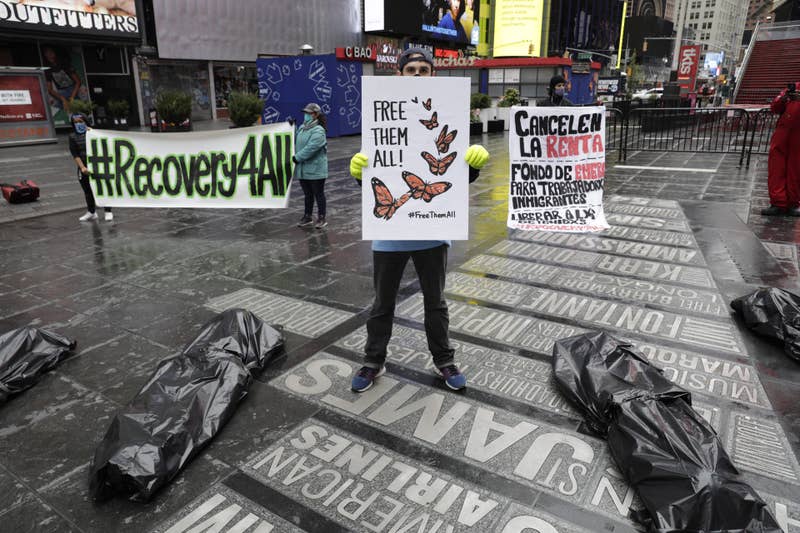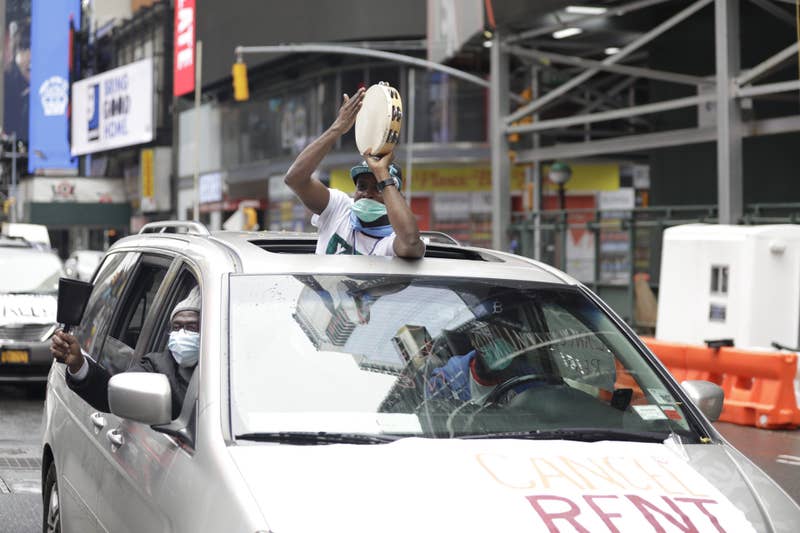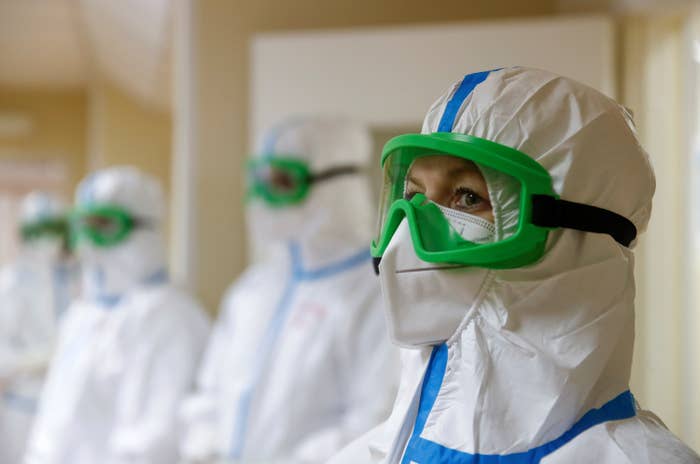BYJOSHUA FREEMAN
In discussions about the last global pandemic, the “Spanish flu,” we never hear about the strike wave that kicked off at the exact same time. But in 1919, one-fifth of American workers walked off the job. We shouldn’t be surprised that labor militancy is spreading during today’s coronavirus pandemic.

Amazon workers hold a protest and walkout over conditions at the company's Staten Island distribution facility on March 30, 2020 in New York City. Spencer Platt / Getty
It is rarely noted that the greatest burst of labor militancy in the history of the United States, the 1919 strike wave, overlapped with the worst health crisis in the country’s history, the 1918–19 influenza pandemic. Four million workers struck in 1919, one-fifth of the workforce, a proportion never since equaled.
Strikes that year were startling not only for the sheer number of workers involved but also for the way they fundamentally challenged the status quo. In Seattle, a strike by shipyard workers expanded into a general strike that shut down the city for a week. In Boston, policemen went on strike. In New York, actors shut down Broadway theaters, while 50,000 men’s clothing workers stayed out of work for thirteen weeks.
In September, some 300,000 workers walked off their jobs in the first national steel strike, taking on the most powerful corporations in the country. In November, nearly 400,000 coal miners struck, defying a plea from President Woodrow Wilson and a federal court injunction.
The Russian Revolution and the growing strength of the British Labour Party infused a spirit of radicalism into even normally conservative sectors of the American union movement. In Seattle and San Francisco, longshoremen refused to load guns intended for use against the new Russian government. Railroad unions called for government ownership of all train lines. Coal miners debated the nationalization of their industry. The great strike wave began during a public health catastrophe.
The Flu and the Labor Uprising
Between August 1918 and March 1919, what was commonly called the Spanish Flu killed at least 30 million people. In the United States, between September 1918 and June 1919 an estimated 675,000 people died, the equivalent of 2.1 million deaths for a population the size of the current United States (very close to recent worst-case predictions for coronavirus fatalities in the absence of preventive measures). The epidemic crested in October 1918 but intensified again in December and January. After another tail-off, a new wave of flu in early 1920 caused still more fatalities.
Many 1919 strikes took place after the epidemic had subsided, but some took place during or immediately after it. In January 1919, during the third of four waves of influenza that were to hit New York City, 35,000 dressmakers — 90 percent female — walked off their jobs to demand a forty-four-hour work week and a 15 percent wage increase to meet the rising cost of living.
In Seattle, the flu hit hard, killing some 1,400 people, in spite of the shutdown of schools, theaters, dances, restaurants, bars, and most other public places and the quarantining of nearby military bases. The city epidemic was in its final phase when 65,000 workers ceased work on February 6, 1919. By the time the steel strike officially ended (in defeat) in January 1920, the epidemic had begun its rebound.
Oddly, connections are almost never drawn between the flu and the labor uprising. Standard accounts of the epidemic almost never mention labor, while standard accounts of labor and the strike wave have, at most, glancing references to the flu, like the use of the epidemic as an excuse to ban meetings by steelworkers.
A quick search of contemporary newspapers and journals suggests that, likewise, they did not often link the two, except metaphorically. The Literary Digest described 1919 as characterized by “an epidemic of strikes.” The Outlook, a New York City weekly, reported “The strike fever is in the air …. The disease that has struck our industrial systems breaks out in one place as it subsides in another.” It is as if the two great disruptions of an era happened in totally separate universes.
The disconnect in part reflects what from our current vantage seems an almost bizarre tendency to downplay or ignore the flu epidemic at the time and in the decades that followed. In November 1918, the New York Times, after two weeks during which 9,000 city residents died from the disease, wrote “Perhaps the most notable peculiarity of the influenza epidemic is the fact that it has been attended by no traces of panic or even excitement.” Historian Alfred W. Crosby noted that in spite of its enormous death toll, the pandemic “never inspired awe, not in 1918 and not since.”
Perhaps the drama of World War I, the subsequent peace process, and the greater familiarity then with death from contagious disease and combat conspired to dull reactions and blank social memory. Who knew that the daughter of Samuel Gompers, the most important labor leader in our history, died of the flu?
To a remarkable extent, life went on during the epidemic. Though there were fairly extensive efforts to reduce the spread of the disease through limiting public interaction, they were nowhere near what we are living through today. Seemingly, flu and labor militancy were separate spheres. There do not seem to have been strikes or other labor protests that directly concerned the flu, its impact on workers and how employers handled it (though since apparently no one has ever tried to study this, perhaps some did occur). Nor is there evidence that the epidemic weighed one way or the other on the success of workers during the great uprising.
But there were profound connections between the influenza epidemic and the strike wave, buried beneath the surface. War, globalization, and capitalist crisis connected the two.
Wartime labor shortages gave American workers unaccustomed power, as fear of job loss from collective action all but disappeared. At the same time, the government, to rally the nation for a battle that would benefit almost no ordinary folk, framed it as a “War for Democracy,” legitimating the notion of democratization as the labor movement sought to give its members some say in the autocratic world of work.
To prevent disruptions of wartime production, Washington forced employers to upgrade conditions and negotiate with workers. As a result, unions made massive gains in membership, power, and social presence during the war. The titanic clash between labor and business after the war stemmed from the effort by workers to protect and extend their wartime gains and by employers to roll them back. The radical thrust of labor action reflected a worldwide sense that the war had disastrously demonstrated the moral and political bankruptcy of ruling elites and opened the possibilities for new ways of organizing society.
The flu, too, was an artifact of war. No one knows exactly how and where it originated, but its rapid spread directly resulted from wartime military mobilization.
The epidemic first hit in the United States, at military bases in the Northeast in August 1918 (though there had been a largely unnoted increase in influenza the previous spring). The Army and Navy proved perfect delivery systems for spreading virus. New recruits were jammed together at training bases, many from rural areas where they rarely had been exposed to any viruses and who carried little immunity. Troops travelled across the country to deployments, often in overpacked trains, spreading the disease to each other and to the civilian population, among which the epidemic peaked two months after it was first identified in the military. Troop and transport ships carried the infection to Europe (including to the American delegation to the Paris peace talks) and ultimately around the world, in an era when the movement of people, goods, and capital across national borders justified the term globalization as much as such flows do today.
Both the flu and strike wave were manifestations of the breakdown of the existing order. Imperialist rivalries brought a carnage of war unprecedented in scale. The impact of the devastation, economically, politically, and socially, bred unrest and accelerated radical challenges, culminating in the Russian Revolution and the worldwide surge of labor and the Left it inspired. Amid the chaos and disruption, the influenza virus found a happy home.
Then and Now
Today, conditions are quite different from 1919. Yet there are overlaps between the coronavirus and Spanish flu pandemics and their links to labor. Our current pandemic is far more disruptive than the 1918–19 outbreak (though it remains to be seen if it will be as deadly). Unlike in 1919, the United States and most other countries have effectively shut down much of their economies to allow social isolation, guaranteeing a deep and perhaps long-lasting economic depression.
Comparatively, the labor movement is much weaker today than it was in 1919, coming off nearly a half-century of declining membership and power. And the relationship between collective worker protest and the flu is very different today than after World War I.
Unlike in 1919, right now we are seeing a flurry of worker protests that stem directly from the epidemic, including petitions, letter-writing campaigns, demonstrations, and even strikes. As many employers treat their workers’ health and their very lives with contempt, failing to provide employees with needed protective equipment, insisting that they work in close quarters, not sending workers with flu-like symptoms home, not disinfecting contaminated spaces, banning the wearing of masks, failing to provide adequate sick or family leave, and not offering any or decent extra compensation for life-threatening work, more and more workers have been speaking up and taking action. Strikes have hit a number of companies, including Amazon, Whole Foods, Perdue Farms, and Instacart, along with bus systems in several cities. Coronavirus-related issues have sped up union organizing campaigns at a number of companies, including Trader Joe’s. Some workers have demanded that their employers use idled workers and resources to fight the epidemic, like the GE aviation division workers who want their factories used to make ventilators.
So far, worker protests have been small in size and short in duration. But things could change. When President Trump touted plans to begin reopening businesses at Easter, though it was obvious that the pandemic would still be raging, talk bubbled up about a general strike. Sara Nelson, International President of the Association of Flight Attendants (and a possible successor to AFL-CIO president Richard Trumka), said that such a general strike was not impossible if there was a widespread sense that “if you don’t take action right now, you’re gonna die.”
World War I gave workers an unusual edge because of the severe labor shortage created by the demands of war production and the cutoff of immigration. The coronavirus is giving workers an edge because they hold the moral high ground. Health workers, grocery workers, postal workers, transit workers, home aides, police and corrections officers, truck drivers, pharmacy workers, sanitation workers, farm workers, and the like, going to work, day after day, under dangerous conditions, have kept the country going. Meanwhile, the moral degeneracy of so many of our business leaders and wealthy elites becomes more and more obvious.
When their lobbyists scurry to get special favors in the bailout bills and they instantly fire employees and end their health insurance (if they ever had it), without making any sacrifices of their own, all from the safety of their comfortable homes or second homes, the deadly consequences of inequities of wealth and power are there for all to see. When Whole Foods, controlled by the richest man in the world, suggested that its workers contribute paid time off to coworkers sick with COVID-19, rather than itself looking after the health and well-being of its workers, the deep rot of the society can’t be missed.
The incompetence of so much of government, especially at the federal level, may also spark more worker action. Washington and many state and local governments spectacularly failed at their most basic responsibility: to protect the health and safety of the people. The cults of privatization, government downsizing, and lean production and distribution have proved disastrous, along with the contempt for expertise, science, and even simple facts. Already, across the country, ordinary people have been stepping into the breach, producing masks and gowns, helping neighbors, unretiring to the front lines.
Perhaps, like World War I, the coronavirus, in unmasking the failures of the old order, may result in a new wave of activism. If this is the best we can do, the time has come to try something radically different. Who knows — we may yet see not just disease, but labor militancy as well, sweep the country, as happened once before.
ABOUT THE AUTHOR
Joshua Freeman is a professor of history at Queens College and the City University of New York Graduate Center. He is the author most recently of Behemoth: The History of the Factory and the Making of the Modern World.
Joshua Freeman is a professor of history at Queens College and the City University of New York Graduate Center. He is the author most recently of Behemoth: The History of the Factory and the Making of the Modern World.
Our spring issue, “Pandemic Politics,” is on its way from the printer and will be released soon. Get a discounted subscription today!
Mike Davis: Reopening the Economy Will Send Us to Hell
Mike Davis
Are You Reading Propaganda Right Now?
Liza Featherstone
Four Futures
Peter Frase
The Red and the Black
Seth Ackerman
Mike Davis: Reopening the Economy Will Send Us to Hell
Mike Davis
Are You Reading Propaganda Right Now?
Liza Featherstone
Four Futures
Peter Frase
The Red and the Black
Seth Ackerman



